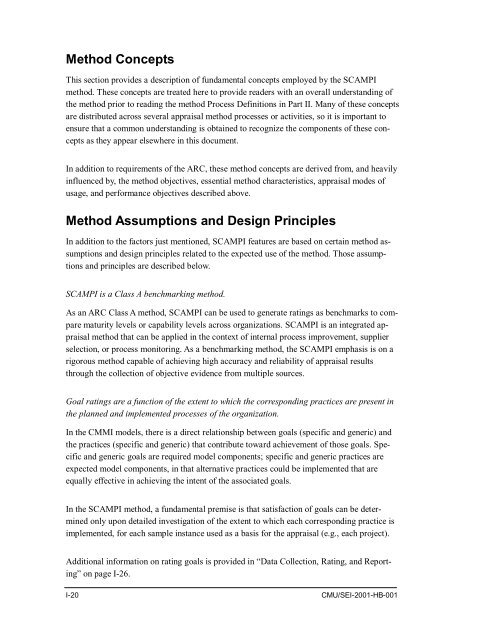Standard CMMI Appraisal Method for Process Improvement (SCAMPI)
Standard CMMI Appraisal Method for Process Improvement (SCAMPI)
Standard CMMI Appraisal Method for Process Improvement (SCAMPI)
You also want an ePaper? Increase the reach of your titles
YUMPU automatically turns print PDFs into web optimized ePapers that Google loves.
<strong>Method</strong> Concepts<br />
This section provides a description of fundamental concepts employed by the <strong>SCAMPI</strong><br />
method. These concepts are treated here to provide readers with an overall understanding of<br />
the method prior to reading the method <strong>Process</strong> Definitions in Part II. Many of these concepts<br />
are distributed across several appraisal method processes or activities, so it is important to<br />
ensure that a common understanding is obtained to recognize the components of these concepts<br />
as they appear elsewhere in this document.<br />
In addition to requirements of the ARC, these method concepts are derived from, and heavily<br />
influenced by, the method objectives, essential method characteristics, appraisal modes of<br />
usage, and per<strong>for</strong>mance objectives described above.<br />
<strong>Method</strong> Assumptions and Design Principles<br />
In addition to the factors just mentioned, <strong>SCAMPI</strong> features are based on certain method assumptions<br />
and design principles related to the expected use of the method. Those assumptions<br />
and principles are described below.<br />
<strong>SCAMPI</strong> is a Class A benchmarking method.<br />
As an ARC Class A method, <strong>SCAMPI</strong> can be used to generate ratings as benchmarks to compare<br />
maturity levels or capability levels across organizations. <strong>SCAMPI</strong> is an integrated appraisal<br />
method that can be applied in the context of internal process improvement, supplier<br />
selection, or process monitoring. As a benchmarking method, the <strong>SCAMPI</strong> emphasis is on a<br />
rigorous method capable of achieving high accuracy and reliability of appraisal results<br />
through the collection of objective evidence from multiple sources.<br />
Goal ratings are a function of the extent to which the corresponding practices are present in<br />
the planned and implemented processes of the organization.<br />
In the <strong>CMMI</strong> models, there is a direct relationship between goals (specific and generic) and<br />
the practices (specific and generic) that contribute toward achievement of those goals. Specific<br />
and generic goals are required model components; specific and generic practices are<br />
expected model components, in that alternative practices could be implemented that are<br />
equally effective in achieving the intent of the associated goals.<br />
In the <strong>SCAMPI</strong> method, a fundamental premise is that satisfaction of goals can be determined<br />
only upon detailed investigation of the extent to which each corresponding practice is<br />
implemented, <strong>for</strong> each sample instance used as a basis <strong>for</strong> the appraisal (e.g., each project).<br />
Additional in<strong>for</strong>mation on rating goals is provided in “Data Collection, Rating, and Reporting”<br />
on page I-26.<br />
I-20 CMU/SEI-2001-HB-001
















